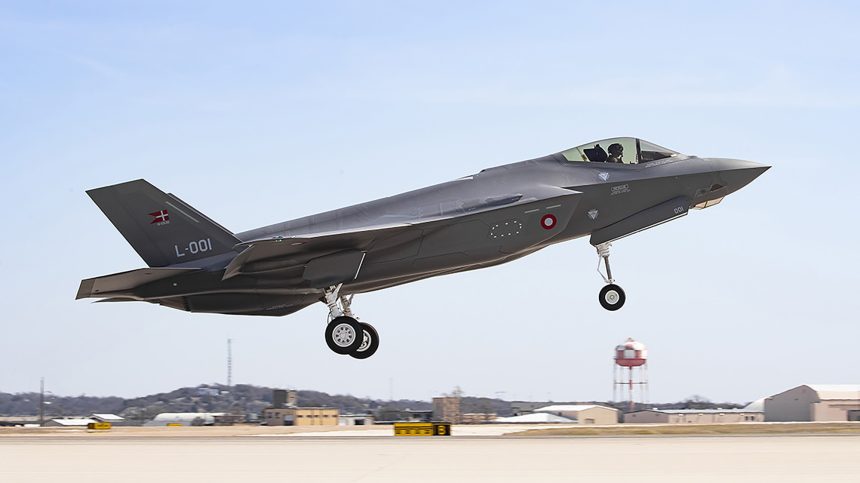New test demonstrated F-35’s ability to collect, analyse and share advanced data across geographically dispersed networks.
RDAF (Royal Danish Air Force) F-35s flying over the U.S. have successfully executed a new flight test validating secure, classified data-sharing between Lightning II jets flying over the U.S. and a Command Center in Denmark. The event, announced by Lockheed Martin on May 19, 2025, marks the latest milestone in the program’s push for full coalition interoperability.
According to a statement released by Lockheed Martin on May 19, 2025, an unspecified number of Danish F-35s flying out of Fort Worth, Texas, shared classified data via DAGGR-2, a Skunk Works’ Open Systems Gateway (OSG) developed under a partnership with the Missile Defense Agency (MDA), through commercial satellite communications and displayed at Skrydstrup Air Base in Denmark.
“This marked a significant milestone toward enhancing Denmark’s capabilities, as it enabled our MDO [Multi-Domain Operations] staff to witness in real-time the potential of the F-35’s ability to collect, analyse and share advanced data across geographically dispersed networks,” said Danish Air Chief, Maj. Gen. Jan Dam. “Our close collaboration with Skunk Works has been instrumental in accelerating the rapid deployment of such capabilities, and we’re very pleased with the results.”
“This collaboration with the Danish MOD enabled us to do what we do best at Skunk Works – rapidly deploy ready-now capabilities at a pace unparalleled in the industry and prove it through real-world flights,” said OJ Sanchez, vice president and general manager, Lockheed Martin Skunk Works. This demonstration builds on our successful track record of collaboration with international partners and defines what truly sets us apart: our commitment to Open Systems Architecture, which enables seamless integration across any platform, sensor, or shooter – regardless of the manufacturer.”
The recent Danish mission is the latest in a series of Multi-Domain Operations (MDO) demonstrations: this is the second major test of the F-35’s classified data-sharing capabilities outside the U.S. The first took place during Ramstein Flag, a major multinational live-fly exercise that began on March 31 and concluded on April 11, 2025
During the exercise, Dutch F-35s operating in an Anti-Access Area Denial (A2AD) environment detected and identified multiple simulated ground targets. Utilizing the Multifunction Advanced Datalink (MADL), the targeting data was transmitted through Skunk Works’ Open Systems Gateway (OSG) into Keystone, the Dutch C2 environment. Keystone then relayed the information to a rocket artillery platform, which engaged and neutralized the target, completing the kill chain within minute
That event, proved that coalition aircraft could exchange mission-critical information across distant sovereign networks, enabling more effective and secure joint operations.
While further technical details of the test remain classified, the public confirmation of such missions marks a notable shift in how the program communicates its progress on allied integration. Until recently, information-sharing between F-35 operators was often discussed in abstract terms.
More tests involving additional partner nations are probably coming in the next months as Lockheed Martin, allied air forces, and national defense ministries continue to refine and expand secure coalition operations.
Generally speaking, these tests also aim to address one of the most sensitive and debated aspects of 5th gen. fighter integration: how to share tactical-level data between allies while maintaining strict data sovereignty. And their successful execution come and in the wake of the controversy about the potential U.S. limitations on foreign-operated F-35s and the supposed existence of a “kill switch”.
Here’s what we recently explained about this controversial topic:
As we explained in detail in a previous article about the “kill switch” myth, according to which the U.S. government has the ability to remotely disable or limit the operational capabilities of foreign-operated F-35 fighter jets, international F-35 operators “are not allowed to conduct independent test operations outside of the Continental United States (CONUS) based on U.S. policy. United States Government (USG) security rules and National Defense Policy (NDP) require that U.S. citizens perform specific functions in order to protect critical U.S. technology.”
While this policy doesn’t constitute a true “kill switch,” it does amount to the U.S. retaining the ability to withhold software updates, effectively leaving the aircraft operational, but increasingly obsolete.
Think of the F-35 like a modern smartphone: a cutting-edge platform that depends on frequent software upgrades to remain at the forefront of capability. To unlock new features, run advanced mission sets, and stay interoperable with the wider network, the jet needs to evolve, continuously.
If you stop updating your smartphone, it doesn’t become useless overnight. You can still make calls and send messages. But as new apps and services emerge, your device falls behind. Security holes go unpatched. Performance degrades. Eventually, it’s no longer fit for purpose in a modern environment…
To a large extent, the F-35 works the same way. It’s not just a fighter jet, it’s a networked sensor-shooter, a 5th-generation combat system built around connectivity, fusion, and adaptability. Without timely updates, it can still fly, but its edge fades rapidly. In a battlespace driven by real-time data, agile threats, and multi-domain complexity, staying current is not a luxury, it’s survival.
This is where the recent Dutch test at Ramstein Flag may signal something bigger.
By successfully demonstrating a live, classified data exchange between an in-flight F-35 and a non-U.S. C2 system, the Royal Netherlands Air Force didn’t just check a technical box, it made a statement.
Despite the centralized nature of the F-35 program and the potential limitations imposed by source code protection and upgrade control, allied operators are actively working to leverage the jet’s advanced capabilities, proving that there is operational value even outside of U.S.-centric architectures.









